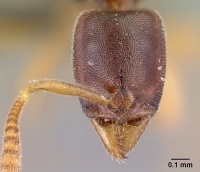Hypoponera quaestio
| Hypoponera quaestio | |
|---|---|

| |
| Scientific classification | |
| Kingdom: | Animalia |
| Phylum: | Arthropoda |
| Class: | Insecta |
| Order: | Hymenoptera |
| Family: | Formicidae |
| Subfamily: | Ponerinae |
| Tribe: | Ponerini |
| Genus: | Hypoponera |
| Species: | H. quaestio |
| Binomial name | |
| Hypoponera quaestio Bolton & Fisher, 2011 | |
Known only from the worker holotype. It was collected in a winkler sample from primary forest leaf-litter.
Identification
Bolton and Fisher (2011) - Described here from a single specimen, Hypoponera quaestio is extremely close to Hypoponera jeanneli and may eventually prove to represent an extreme variant of that species. However, the holotype is darker in colour than any jeanneli examined and appears to lack distinct setae on the first and second gastral tergites except at the posterior margin of each segment. In profile, short, slightly elevated pubescence is conspicuous on both tergites but the one or two minute standing components appear to be pubescent hairs that are slightly more elevated, not distinct setae. In dorsal view the sides of the second tergite of quaestio lack projecting setae. Conversely, in unabraded specimens of jeanneli, the first and second tergites, in profile, show a number of short, standing setae that are distributed over each sclerite that are distinct from the pubescence, and similar projecting setae occur on the sides of the second tergite in dorsal view. Most measurements and indices of quaestio fall within the range of jeanneli, but its petiole is slightly higher in profile and broader in dorsal view, which results in slightly higher values of PeS, PeNI and DPeI.
A member of the abeillei group.
Keys including this Species
Distribution
Latitudinal Distribution Pattern
Latitudinal Range: -5.732599° to -5.732599°.
| North Temperate |
North Subtropical |
Tropical | South Subtropical |
South Temperate |
- Source: AntMaps
Distribution based on Regional Taxon Lists
Afrotropical Region: United Republic of Tanzania.
Distribution based on AntMaps
Distribution based on AntWeb specimens
Check data from AntWeb
Countries Occupied
| Number of countries occupied by this species based on AntWiki Regional Taxon Lists. In general, fewer countries occupied indicates a narrower range, while more countries indicates a more widespread species. |

|
Estimated Abundance
| Relative abundance based on number of AntMaps records per species (this species within the purple bar). Fewer records (to the left) indicates a less abundant/encountered species while more records (to the right) indicates more abundant/encountered species. |

|
Biology
Castes
Queens and males have not been collected.
Nomenclature
The following information is derived from Barry Bolton's Online Catalogue of the Ants of the World.
- quaestio. Hypoponera quaestio Bolton & Fisher, 2011: 93, figs. 103-105 (w.) TANZANIA.
Unless otherwise noted the text for the remainder of this section is reported from the publication that includes the original description.
Description
Worker
Holotype. Measurements: HL 0.63, HW 0.52, HS 0.575, SL 0.44, PrW 0.41, WL 0.84, HFL 0.44, PeNL 0.18, PeH 0.42, PeNW 0.31, PeS 0.303. Indices: CI 83, SI 85, PeNI 76, LPeI 43, DPeI 172.
Eyes minutely present, each appearing to consist of one slightly larger and two very small ommatidia. Apex of scape, when laid straight back from its insertion, just fails to reach the midpoint of the posterior margin in full-face view; SL/HL 0.70. Cephalic dorsum densely reticulate-punctate. Pronotal dorsum superficially but quite densely punctate except for midline which is smooth; pronotum obviously much less strongly and densely sculptured than cephalic dorsum. Metanotal groove absent from dorsum of mesosoma but with a slight change of slope between mesonotum and propodeum. Propodeum weakly marginate between declivity and side. Posterior surface of petiole node with a series of about 8–9 very short cuticular ridges that radiate upward from the peduncle. The outer ridge on each side is visible in profile as a short, vertical carina that ascends the posterolateral edge of the node above its base. Node of petiole in profile with the anterior and posterior faces approximately parallel. Subpetiolar process with a ventral angle. In dorsal view petiole node with posterior face transverse; sides and anterior face form a sin-gle convex surface, but not thickly D-shaped. Maximum width of first gastral tergite in dorsal view (ca 0.48) subequal to width of second gastral tergite at its midlength (ca 0.47). Cross-ribs at base of cinctus of second gastral tergite strongly developed and conspicuous. Midline length of second gastral posttergite, from posterior margin of cinctus to apex, is less than the width of the segment at its midlength. Disc of second gastral tergite with sharply incised punctures that are quite close-packed but separated by areas of glossy cuticle; the diameters of the punctures are equal to, or slightly less than, the distances that separate the punctures. First and second gastral tergites dorsally pubescent but without standing setae that project above the level of the pubescence. Colour brown.
Type Material
Holotype worker, Tanzania: Kilimanjaro Region, Kindoroko Forest Reserve, 1739 m., 5-8.ix.2005, 3.74520S, 37.64267E, CEPF-TZ-5.2-F03, primary forest leaf litter, Winkler (P. Hawkes, J. Makwati, R. Mtana) (South African Museum).


